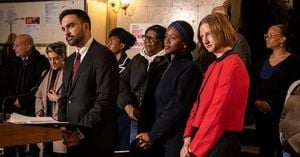The vibrant Irish rap scene has been making waves again, this time with the release of a new bilingual track that bridges cultures, languages, and generations. Cork’s beloved rap group, Kabin Crew, have just dropped “Meas Mór,” a dynamic collaboration that fuses Irish and Scots Gaelic in a way that’s as infectious as it is meaningful. The track, which landed just before mid-September 2025, is already being hailed as a celebration of both Ireland’s and Scotland’s unique cultural heritages, and it’s got fans and language advocates buzzing on both sides of the Irish Sea.
According to The Echo, “Meas Mór” was written and performed by Kabin Crew alongside the talented young voices of Scotland’s Tinderbox Collective. The song doesn’t just pay lip service to bilingualism—it fully embodies it, with Irish and Scots Gaelic lyrics flowing seamlessly as the youths from each country take turns rapping in their native tongues. The result is a high-energy anthem that, as The Echo puts it, “puts even some of the hits from Kneecap to shame”—a bold claim, considering Kneecap’s reputation as trailblazers in the Irish rap world.
But what really sets “Meas Mór” apart is its commitment to accessibility and inclusivity. The accompanying music video, filmed in both Edinburgh and Cork, is peppered with recognizable landmarks—Belle’s Field and the Quad at University College Cork among them. For those who aren’t fluent in Irish or Scots Gaelic, the video offers a clever solution: subtitles that change color depending on the language being rapped, with blue for Scots Gaelic and green for Irish. It’s a small touch that makes a big difference, inviting viewers of all backgrounds to engage with the music and the message.
This isn’t Kabin Crew’s first foray into Irish-language rap, but it does mark a significant step in their evolving relationship with the language. As The Echo reports, the group has been increasingly experimenting with Irish ever since participating in the Kabin Studio’s Irish songwriting summer camp in 2024. That experience, it seems, has sparked a creative fire. Since then, Kabin Crew has released several tracks as Gaeilge and shows no signs of slowing down. Their growing embrace of the Irish language is mirrored in the wider youth culture, where music, television, and even reality shows are helping to shift perceptions and make the language feel relevant—and cool—again.
It’s not just the music scene that’s driving this change. Over in Northern Ireland, Niall McKeown, a 25-year-old maths tutor from Coalisland, Tyrone, has become an unlikely champion of the Irish language. As reported by the Irish Independent, Niall recently appeared as a contestant on the TV show Traitors, where he quickly became a fan favorite during an Irish-language themed mission. His performance not only helped his team secure a win, but also inspired a wave of positive feedback from teachers and young viewers alike.
“I think it is so good, it’s the young generation that is going to keep the language growing so it is,” Niall told the Irish Independent. He’s seen firsthand how media exposure can spark curiosity and pride in the language among children. “That’s what I always said, if even for two seconds of that mission if I could get a young child to think ‘oh my God, the Irish language is cool’, which has happened because I have had teachers text me saying ‘I’m got to use this as a learning tool’, like what you can do and where the language can get you.”
Niall’s enthusiasm for Irish-language rap is clear—he counts himself a fan of Kneecap, the group often credited with bringing an edgy, contemporary twist to Irish-language music. He believes that artists like Kneecap, and now Kabin Crew, are helping to raise awareness and appreciation for the language, especially among younger generations. “If we can highlight it, which Kite entertainment and RTÉ have done, that the language is being used, and is cool to have it — that’s a job well done.”
Despite being one of the early contestants eliminated from Traitors, Niall remains upbeat about his experience and the visibility it brought to the Irish language in Northern Ireland. “I think it shows the Gaels that we’re still here in the North and to highlight that,” he said. “The mission relied heavily on a young lad from the North to show that the language is going from strength to strength here. The language really put me in the limelight.”
For Kabin Crew, 2025 has been a whirlwind year. Beyond the release of “Meas Mór,” the group recently enjoyed a red carpet moment at the Cork premiere of the film Christy and even teamed up with RTÉ legend Bryan Dobson for a new tune, according to The Echo. Their calendar remains packed: a surprise performance is slated for Cork city centre on Culture Night next week, and they’re set to star in an upcoming documentary exploring the use of the Irish language at Kabin Studio. New tracks are also in the pipeline, promising that the group’s creative momentum is far from spent.
What’s remarkable about this cultural moment is the sense of collaboration and mutual respect that underpins it. “Meas Mór” isn’t just a catchy single—it’s a statement about the power of language to connect people across borders, backgrounds, and generations. The partnership with Tinderbox Collective, the cross-country filming, and the careful attention to accessibility all reflect a broader movement to make minority languages visible, vibrant, and valued. It’s a movement that’s finding allies in unexpected places: from reality TV contestants to established broadcasters, from schoolteachers to young rappers with something to say.
Of course, the road ahead isn’t without challenges. While the Irish language is experiencing a resurgence in some circles, it still faces significant hurdles in terms of everyday use and institutional support, especially in Northern Ireland. But the energy and optimism radiating from projects like “Meas Mór” and voices like Niall McKeown’s suggest that the seeds of change are being sown—and that music and media have a crucial role to play in nurturing them.
As Kabin Crew prepares for their next performance and Niall reflects on his time in the spotlight, one thing is clear: the Irish language is not only surviving but thriving, fueled by the creativity and passion of a new generation. Whether through rap battles, reality TV, or community workshops, the message is getting out there. And as more young people discover that Irish—and Scots Gaelic—can be as cool and contemporary as any global trend, the future for these languages looks brighter than it has in years.




